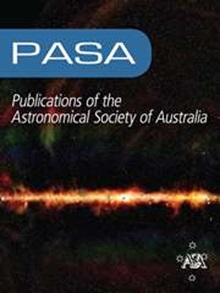环星系中的Hi巡天(Hi- rings) -棒子对环星系中Hi气体的影响
IF 4.6
3区 物理与天体物理
Q1 ASTRONOMY & ASTROPHYSICS
Publications of the Astronomical Society of Australia
Pub Date : 2023-04-02
DOI:10.1017/pasa.2023.19
引用次数: 0
摘要
摘要:我们利用澳大利亚望远镜紧凑型阵列(ATCA)对环状星系进行了新的高分辨率中性原子氢(Hi)巡天。我们以Buta(1995)南环星系调查目录中的24个环星系为样本,研究共振、碰撞和相互作用驱动的环星系的起源。在这项工作中,我们介绍了样品的概述,并研究了它们的全局和解析Hi属性。此外,我们还通过测量它们的恒星形成速率(SFR)和它们的分辨SFR表面密度曲线来探测它们的恒星形成特性。我们发现样本中的大多数棒状星系都是缺乏Hi的,这暗示了棒状星系在驱动它们的Hi缺乏方面的作用。此外,对于我们样本中特殊演化的棒环星系,我们应用Lindblad的共振理论预测了共振环的位置,并在预测和观测之间找到了很好的一致性。我们确定了Hi气体和/或恒星形成的环共同位于一个或其他主要共振。最后,我们测量了我们星系的一个子样本的条形图案速度($\Omega_{\textrm{bar}}$),发现其值在10-90 $\textrm{km s}^{-1}$ kpc $^{-1}$之间,与之前的研究结果很好地吻合。本文章由计算机程序翻译,如有差异,请以英文原文为准。
The Hi in Ring Galaxies Survey (Hi-RINGS)—Effects of the bar on the Hi gas in ring galaxies
Abstract We present a new high-resolution neutral atomic hydrogen (Hi) survey of ring galaxies using the Australia Telescope Compact Array (ATCA). We target a sample of 24 ring galaxies from the Buta (1995) Southern Ring Galaxy Survey Catalogue in order to study the origin of resonance-, collisional- and interaction-driven ring galaxies. In this work, we present an overview of the sample and study their global and resolved Hi properties. In addition, we also probe their star formation properties by measuring their star formation rates (SFR) and their resolved SFR surface density profiles. We find that a majority of the barred galaxies in our sample are Hi-deficient, alluding to the effects of the bar in driving their Hi deficiency. Furthermore, for the secularly evolving barred ring galaxies in our sample, we apply Lindblad’s resonance theory to predict the location of the resonance rings and find very good agreement between predictions and observations. We identify rings of Hi gas and/or star formation co-located at one or the other major resonances. Lastly, we measure the bar pattern speed (
$\Omega_{\textrm{bar}}$
) for a sub-sample of our galaxies and find that the values range from 10–90
$\textrm{km s}^{-1}$
kpc
$^{-1}$
, in good agreement with previous studies.
求助全文
通过发布文献求助,成功后即可免费获取论文全文。
去求助
来源期刊
CiteScore
5.90
自引率
9.50%
发文量
41
审稿时长
>12 weeks
期刊介绍:
Publications of the Astronomical Society of Australia (PASA) publishes new and significant research in astronomy and astrophysics. PASA covers a wide range of topics within astronomy, including multi-wavelength observations, theoretical modelling, computational astronomy and visualisation. PASA also maintains its heritage of publishing results on southern hemisphere astronomy and on astronomy with Australian facilities.
PASA publishes research papers, review papers and special series on topical issues, making use of expert international reviewers and an experienced Editorial Board. As an electronic-only journal, PASA publishes paper by paper, ensuring a rapid publication rate. There are no page charges. PASA''s Editorial Board approve a certain number of papers per year to be published Open Access without a publication fee.

 求助内容:
求助内容: 应助结果提醒方式:
应助结果提醒方式:


